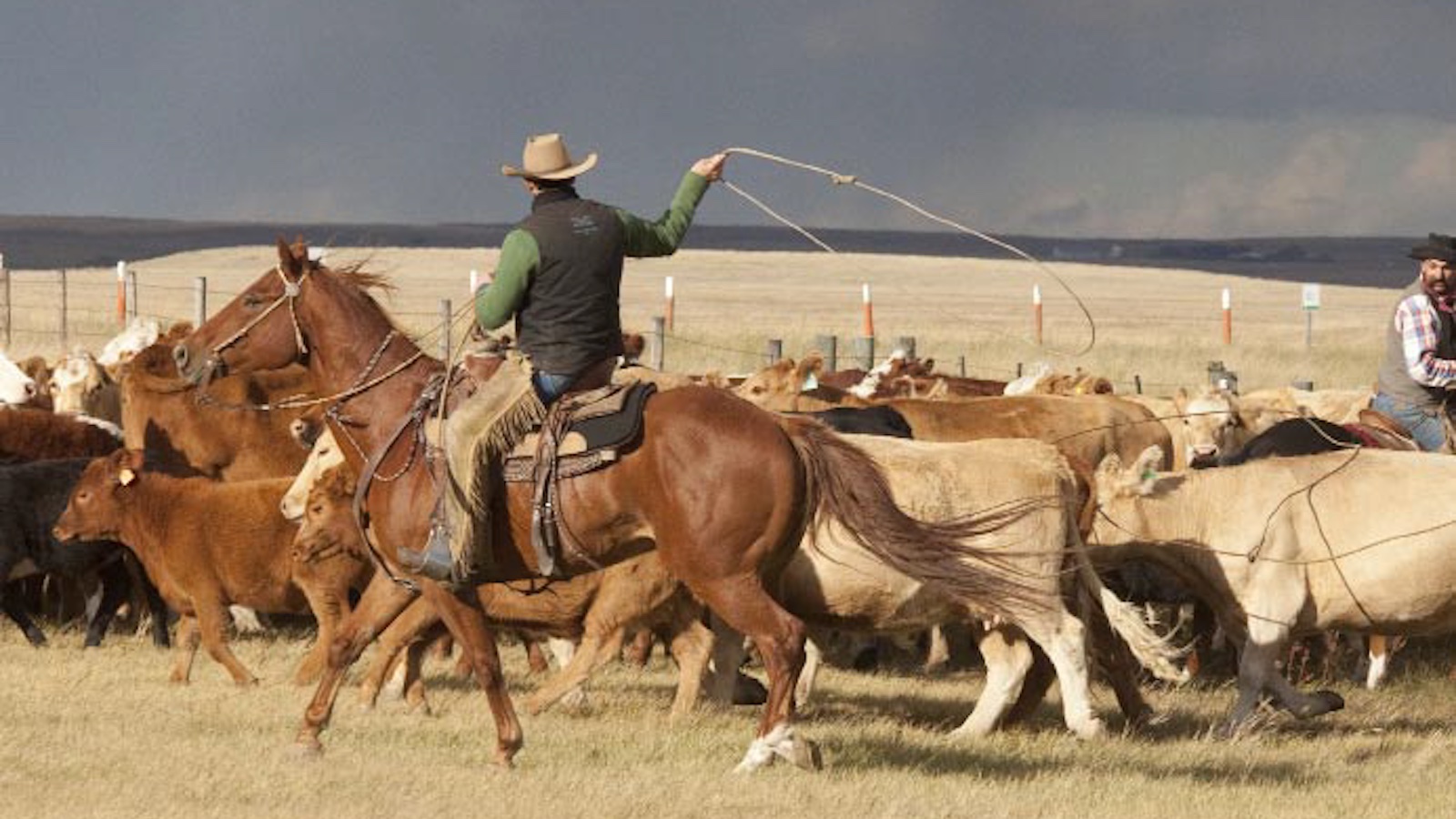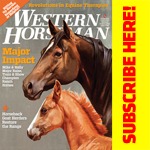In Canada, a 77-year-old ranching tradition called the Community Pasture Program is coming to an end. Over the next four years, the Queen of England will divest herself of 2.2 million acres of prairie land, bidding adieu to some 300 government employed cowboys. What will become of them remains unclear.
Blowing dirt doesn’t respect fences.
On May 9, 1934, a dust storm kicked up, and for the next two days it made its way 1,800 miles across North America. The northern prairies had been wrung dry by a six-year drought, and wherever the land was overgrazed or ploughed under, the topsoil parched under a relentless sun. A wind gust lifted the first grain of dirt, probably somewhere in southern Saskatchewan, the piano key-shaped province of Canada. The wind blew south into Montana, adding more prairie dirt to a collection it carried east into the Dakotas.

By the time the dust storm hit Minnesota, wind speeds measured 47 miles per hour, and the “roller,” as dust storms were called in the 1930s, blackened the sky. In Chicago, it dumped 12 million tons of dirt. And still the roller went east. In New York, dust blocked the view from the observation deck atop the Empire State Building. The Statue of Liberty was obscured by a black cloud as the storm blew 200 miles out to sea, where it dusted the decks of cargo ships on the Atlantic Ocean.
Such is the power of a prolonged drought on the northern prairies.
In the United States, the Dust Bowl is thought of as primarily affecting the American South. That owes, at least in part, to the captivating images taken by Civilian Conservation Corps photographers like Arthur Rothstein, Dorothea Lange and Walker Evans. Their pictures of wind bitten homesteaders in Oklahoma, Texas and Alabama have become national symbols of the hardships faced during the Great Depression. However, draw a circle around the greater region impacted by the droughts of the 1930s, and the Dust Bowl looks more platter-shaped, stretching from the Texas Panhandle to the prairies of Saskatchewan.
Choice of metaphorical kitchenware aside, the United States and Canadian governments were forced to act in order to protect their nations’ farm and ranch industries. In Washington, D.C., as prairie dust seeped through the cracks of the White House doors and windows, President Franklin D. Roosevelt worked on the New Deal. He enacted the Drought Relief Service to buy cattle that were at risk of starvation, and signed the Soil Conservation and Domestic Allotment Act, which paid farmers to not plant crops in order to combat soil erosion.
North of the border, in Ottawa, the Canadian Parliament enacted the Prairie Farm Rehabilitation Administration (PFRA). One function of that agency was to purchase abandoned and condemned homesteads and turn them into “community pastures.” The initiative was inspired by a communal ranching model invented by the province of Saskatchewan a decade earlier. In 1922, after the American based Matador Land and Livestock Company forfeited a lease on 117,000 acres, the province took over management of the land, hiring its own cowboys to provide grazing services to area ranchers. The PFRA, a federal program, aimed to do the same as a way to rehabilitate large tracts of drought-stricken land, while also providing pasture for the region’s half-starved cattle herds. To run the federal Community Pasture Program, the PFRA hired cowboys who rode for the brand of the Canadian maple leaf, not any brand on the hide of cow.
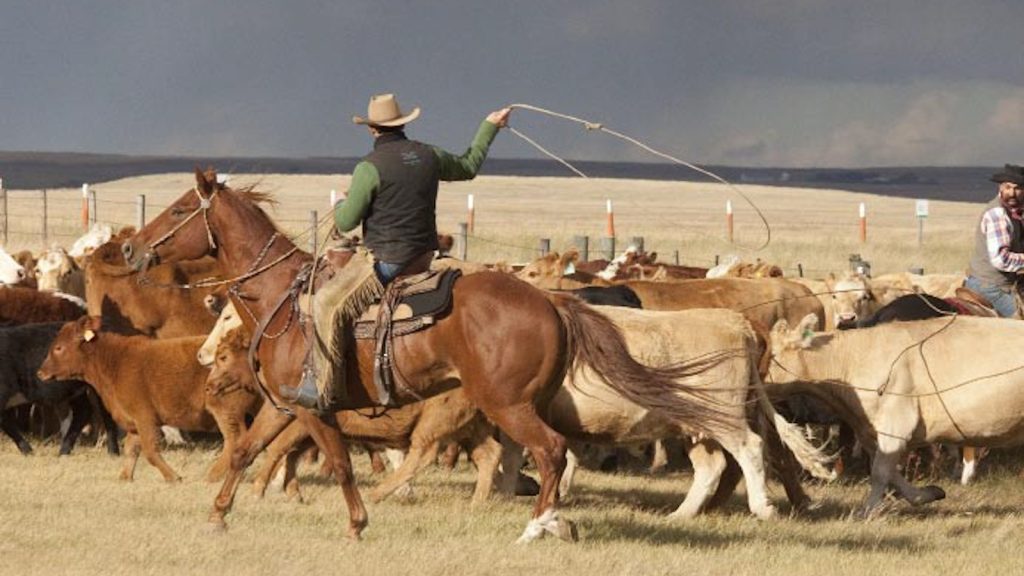
“Cowboys here rode not for rugged individualism but for state initiative and cooperative enterprise,” wrote historian Tom Isern.
The droughts of the 1930s are considered the worst weather events of the 20th century. Those original community pasture riders were cowboys who understood the importance of intact grassland ecosystems in the battle against drought. They prided themselves on working from horseback, they scorned the plow, and they felt the same way about a spring shoot of grass as they did a newborn calf. Through the next 75 years, their ranks grew to 300 cowboys on 85 community pastures in Alberta, Manitoba and Saskatchewan. The program’s 2.2 million acres provided grazing for 220,000 cattle, an anchor of stability in the center of Canada’s most productive cattle country.
“It’s the best job I’ve ever had,” says Kelly Ashdown, a 40-year veteran who currently manages a 24,000-acre community pasture near Swift Current, Saskatchewan. “I spend my days on horseback, out here chasing cows. How can you go wrong?”
But in 2012, the Canadian Parliament gave the “royal assent” to pass Bill C-38, also called the Jobs, Growth and Long-Term Prosperity Act. The law, a budget-cutting measure, mandated the PFRA’s closure. The Queen of England, figurative head of the Canadian government, would divest herself of all federal community pastures, transferring the lands to their home provincial governments. Saskatchewan stood to benefit the most, as home to 62 community pastures totaling 1.77 million acres. But the province said it had no intention of absorbing the PFRA lands. Officials said that the few provincial community pastures it ran, like the Matador, were enough. Instead, Saskatchewan would consider leasing the lands to private ranchers, and possibly even sell the land outright.
The Canadian government is on a strict timeline to divest all 85 community pastures before 2018. And so, for the cowboys of the community pastures, each day moving forward is a countdown to their final cattle roundup. Last September, I rode with the cowboys of the Big Stick Community Pasture in southwest Saskatchewan to catch a glimpse of the PFRA’s vibrant cowboy culture before it vanishes.
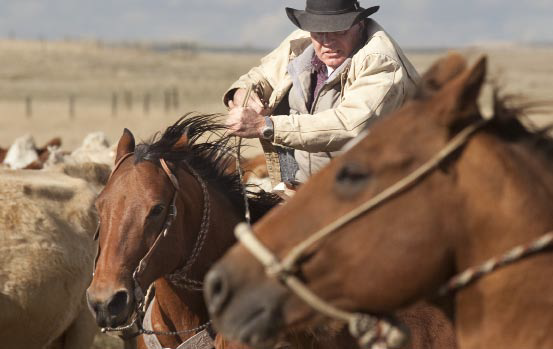
On September 30, 2013, a high-wind warning was in effect along the Alberta-Saskatchewan provincial line as I traveled eastbound on the Trans-Canadian Highway. That semi-arid region of Canada is known as Palliser’s Triangle, named for expeditionary leader John Palliser, who, after surveying the region from 1857 to 1859, warned that western Canada was not suitable for agriculture. With a 60-mph tailwind buffeting my car dangerously close to the roadside, I concluded that it wasn’t well suited for driving, either. In Medicine Hat, I stopped for gas at a 7-Eleven, parking under a metal canopy that moaned and vibrated in the wind. My windshield was insect-speckled, but when I reached for the squeegee, all the water had sloshed out of the reservoir. Twenty miles down the highway, I crossed the provincial line where a sign read: “Saskatchewan, Naturally.” In a field beyond, several horses stood like weather vanes with their butts to the wind. And on the horizon, I saw the makings of a dust storm, albeit a small one compared with the rollers of the 1930s. The big difference between then and now was that this summer had been one of the wettest in recent memory. Native grasses and shrubs stood verdant and tall, blowing in the wind, guaranteeing that the prairie would keep her topsoil for another season.
Just before sunset, I drove into the headquarters of Big Stick Community Pasture, located 25 miles north of Maple Creek, Saskatchewan. The manager’s longtime girlfriend, April Wright, met me in the driveway and said that the man of the house was elbow-deep in a plumbing emergency in their basement. She carried her shoulders swept back and wore short-cropped hair—a sensible cut for a windy climate. She invited me inside for a Kokanee beer and we sat around the kitchen table making small talk.
We heard footsteps on the basement stairs.
“Is the water back on yet?” she yelled down the hallway. “I’ve got eight cowboys to cook for and I can’t start without water.” The footsteps retreated. “Where were we?” she asked me.
April’s spunk was her best asset for surviving the harsh northern prairies and not letting it snuff her firelight. Still, I got the sense that living in the middle-of-nowhere Saskatchewan, with a man who was betrothed to the land, had worn her down and that she didn’t mind the Community Pasture Program’s ticking clock.
The footsteps came back upstairs and I was about to finally meet Mert Taylor, a man the Canadian press called a “cowboy conservationist,” portraying him as a whistleblower against the PFRA divestiture. We’d spoken several times over the telephone, as I tried to get press credentials for a visit, but our requests were initially denied. Evidently, Agriculture Canada wanted Mert muzzled. They had taken a black eye in the press, and now the last thing they wanted was more coverage about the friendly, handsome, well-spoken, veteran pasture manager who believed that dissolving the Community Pasture Program was a dim-witted idea. But that they wouldn’t even let Mert talk to a cowboy magazine frustrated him.

“It’s like they won’t acknowledge we exist,” he’d said over the telephone. “It’s a strange way to thank our guys for their service.”
I figured that if community pastures are public lands, what was to stop me from dropping by for a visit on a day that happened to be fall roundup?
In person, Mert looked like Harrison Ford’s twin brother. He had the same cleft chin, crooked smile and sandy voice. Well, Mert’s nose was a bit bigger and his bank account shallower, but otherwise the resemblance was there.
With the plumbing crisis solved, we climbed into his truck to run an errand across the ranch. Tomorrow, the plan was to gather 450 cow-calf pairs and pre-sort them, in anticipation of their owners coming to ship out for the fall. The ranch had 2,000 head running around wearing 24 different brands, and herd management was no small task. Mert wanted to drop off two extra cutting horses at the sorting pens. For the morning gather, he planned to use free-moving horses that could cover a lot of ground. But if anything should wear out, there’d be fresh mounts available for working in the pens.
As we trailered across the ranch, Mert explained how a community pasture works. Each “patron,” as a cattle owner is called by the PFRA, has one allotment of 45 pairs. For a fee of $125 per pair, the patron gets a season of grazing (May through October, weather dependent) plus breeding service from one of Big Stick’s herd bulls.

“We used to keep Hereford and Charolais bulls,” Mert said, “but the Patrons Association voted to switch over to Red and Black Angus.”
Patrons have a say on big-picture issues, but on the day-to-day situations, they abide by a set of rules that insulate community pasture managers from their influence. First, a community pasture is for breeding cattle only, not for fattening stocker cattle. Second, all livestock must be vaccinated and branded, and any bull calf castrated before arrival. Third, the cattle are under the managers’ absolute control from the moment they are delivered in the spring until when patrons ship out in the fall.
“It would cause too many problems if the patrons visited all the time,” Mert says. “They’d bring their dogs, trample the grass, ride through each others’ cattle and leave gates open. The program works because the patrons are hands-off. Besides, most of these guys have farms of their own to run. They’re not losing sleep over their cows.”

Finally, patrons accept that pasture managers have certain priorities. Managers are ultimately responsible to the Canadian government for the health of the land, and if drought hits they shorten the grazing season. A patron might be a multi-generational cattleman, but he trusts that when it comes to managing cattle on prairie rangeland, a community pasture manager is the expert.
Mert put me up in the sleeping quarters of his horse trailer. The wind rocked it through the night, masking any noise made by the rest of the roundup crew’s arrival. I met them the next morning seated around April’s breakfast table. We ate sausage-and-egg casserole that was a testament to what water can do for cooking. There was Jeff Taylor, Mert’s son; Riley Millar, a pasture rider hired to work on Big Stick for the summer; Frank Willman, a day-rider from Maple Creek; and Shawn Wells, Jesse Heinze and Kobe Herr, a trio of cowboys who’d traveled the windy highway from Pincher Creek, Alberta.
We downed our last cups of coffee, then stepped outside into a dark, cold dawn to saddle horses and load up. To minimize vehicle shuttling at the end of the day, the eight of us crammed into the cab of Mert’s truck. I got the middle seat upfront, meaning Mert jabbed me with his elbow every time he turned the steering wheel. Next to me, Jesse and Kobe were lumped onto the passenger seat. Sardines have more legroom in a tin can.
We got brief reprieves from claustrophobia whenever Mert stopped at a ranch gate. Somebody would somehow pull the door handle and whoever fell out first opened the gate. It took us 30 minutes to travel the distance a meadowlark could fly in five. Along the way, we passed several ponds and lakes whose saline waters crusted the shores white. The water was rank to cattle, but heaven for flocks of birds that puddle-jumped from one body to the next. Environment Canada has designated the community pastures as critical habitat for 20 at-risk wildlife species, including piping plover, sage grouse, burrowing owls, swift fox and black-footed ferrets. Conservation groups have learned that since pasture managers care for the grasslands, they are valuable allies in the protection of wildlife.
Finally, Mert parked at the far edge of the pasture we would gather that morning. The sun clipped the horizon, and the wind picked up speed. Mert wore a stampede string cinched tight as baling twine under his chin. My hat didn’t have one, so I smashed it down around my ears and hoped for the best. April had loaned me her dead-broke buckskin horse, Coy, and he barely twitched an ear the dozen times my hat went flying across the prairie.
Mert divided us into two groups and we fanned out going in either direction.
“Keep the nearest guy in sight,” he yelled over his shoulder, galloping off.
That was easier said than done. The topography was filled with mounds, gullies, aspen tree stands and the occasional sand dune. It was like riding through a post-apocalyptic golf course. The height differential between land features was 20 feet— enough to hide a small bunch of cattle. To do a thorough job gathering, I rode a winding route between them, often losing sight of a cowboy named Riley Millar who rode to my right.

Riley was Mert’s full-time pasture rider. When we met the night before, I wasn’t sure what to make of him. He wore Elvis Costello glasses, a green and white plaid jacket, and clashing polka-dot neckerchief. Now, as I rode alongside Riley and watched him put a flashy gray gelding to work, I saw that he was a handy cowboy with an idiosyncratic fashion sense that dared you not to misjudge him.
If Mert typified a veteran community pasture manager, Riley was an example of the up-and-coming cowboy with a promising career ahead of him. He’d hired on with Mert because working for the community pastures program was a family business. His grandfather, dad, uncles and cousins all worked for the PFRA. Riley estimated that in total, his family had served 100 years in the Community Pasture Program.
Herein lies one of the intangible benefits the Community Pasture Program provides to Canadian society: developing a talent pool of well-qualified cowboys and ranch managers. Saskatchewan produces 80 percent of Canada’s beef. After the Community Pasture Program shuts down, the ranching industry could suffer a depleted supply of field tested cowboys entering the job market.
The afternoon was getting on by the time we reached the sorting pens, and the wind chill was dropping fast. In the sky, the wind had raked the clouds into fluffy windrows. The sun cast their shadows across the prairie, where they scuttled along as if by conveyor belt. We penned the cattle, loosened our horses’ cinches and took refuge in a nearby barn, where April had set out Igloo coolers filled with roast-beef sandwiches, a large Thermos of coffee and a plastic container of store-bought cookies.
With so much work ahead, there wasn’t a lot of time to sit around socializing. April saddled one of the spare horses in order to help out. Soon everyone sat mounted in the sorting pen listening to Mert’s instructions. The first cull, he said, was anything wearing an “EZ” or “E–” brand. The riders spread out and went to work.
The night before, Mert had told me how he’d redesigned the sorting corrals according to an A-pen design he learned from Idaho horseman Martin Black. At the point of the “A” were two 12-foot sorting gates. The bottom was 500 feet wide, room enough for the riders to sort the cattle in a controlled environment. Black explained that the arrangement helped a cutting horse learn the offense and defense involved in sorting. Mert’s embrace of the A-pen design exemplifies how up-to-date community pasture cowboys are about Western ranching techniques. And he was equally as passionate about innovations in Western horsemanship.
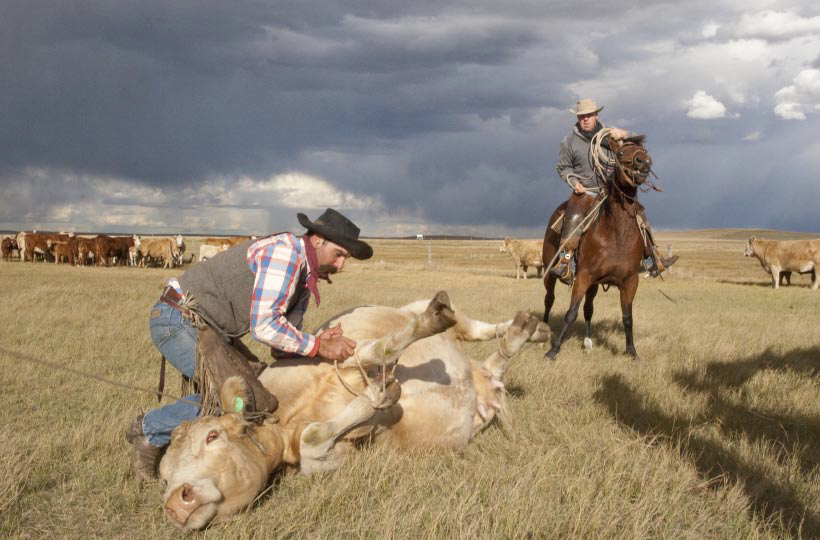
“When I worked as a seasonal pasture rider,” Mert explained, “I could travel around and learn from a bunch of different horsemen every summer. But when I became a pasture manager and got locked into one property, I figured that if I couldn’t travel around, I could at least bring good horsemen to me.”
Through the years, Mert has organized a who’s-who list of visiting clinicians, including Black, Bryan Neubert, Ray Hunt, Pat Parelli, Les Vogt and Sam Meads. He started by figuring out what aspect of Western horsemanship he wanted to improve onpen work, natural stockmanship, cow horse training, ranch roping, colt starting—and then found the best clinician to teach him about it. Local horsemen came to rely on Mert’s clinic schedule as a way to improve their cowboy skills.
That explained the crew’s impressive display of riding and roping as they sorted the cattle. The riders were precise but soft in their leg and rein cues, to which the horses responded sharp and fast. I didn’t notice anything uniquely “Saskatchewan” about their gear, other than they were typical melting-pot cowboys who had taken the best of what each region has to offer. But a few commonalities did bubble to the surface. Owing to the cold weather, all but one of the cowboys rode in shotgun chaps. They also favored Santa Ynez reins connected to heavy, long-shanked bits. Riley and Jeff, however, rode with mecates. Jeff, because he was putting miles on a colt that day. Riley, perhaps, because he had a contrarian style to uphold.
The cowboys carried long ropes—50-foot plus—a few of them even reatas, tied at the pommel. And they could throw. On a few occasions, when somebody spotted an animal needing doctoring, the cowboys angled in and took long throws, trying for complicated catches first, like houlihan and overhand- shoulder shots. After that, anything went.
The only other distinction of note was the proliferation of get-down ropes. Which made sense, given how dang big and fenceless the community pasture country was.
In addition to being a cowboy talent pool, the PFRA has created a pipeline of well-trained ranch horses that get sold on the open market.

“PFRA horses have good reputations,” Kelly Ashdown later told me when I visited his community pasture near Swift Current. “People know they’ve seen it all: snow, rain, mountains, cold. We put them through the mill.”
The PFRA covers the cost to community pasture riders of keeping their own horses. Like Jeff Taylor, who rode a colt during our roundup, a cowboy can draw wages while also investing time into a horse that will one day pay dividends. Kelly sells up to four horses a year, each fetching about $5,000.
“The money’s all profit,” he said.
Rather than squander it, he uses a portion to buy new prospects at auction, and then puts the rest into a retirement account. Kelly calls it his “travel fund.” Pensioned pasture managers like him and Mert face a harsh reality when they retire: Their life’s work stays behind on the ranch. They hold no equity in land or livestock.
“It can be hard knowing that the house you live in isn’t your home,” Kelly said.
When the PFRA fully divests in 2018, at least the cowboys will have a pension to fall back on. The same isn’t true for many of their peers. Young pasture managers are finding out that what they’d thought was a stable career path is crumbling beneath them. Community pasture jobs used to fill quicker when they posted. But for the coming year, nearly half still have openings. Up-and-coming cowboys know there’s no PFRA career ladder to climb, so there’s no use working a seasonal job that won’t count as a foot in the door.

Kelly said that hiring has become difficult during these interim years of the divestiture. Mert was lucky to have found a qualified young hand like Riley, while his own son, Jeff, had already embraced the reality that his future lies in private ranching.
That night, after supper, we hung around doing what cowboys everywhere know how to do best: drink whiskey, play guitar and tell stories. We talked late into the night, discovering how interconnected the American West is when you realize that the northern prairies aren’t a region that stops at the Canadian border.
Jeff stood at the door and said, “You’ve gotta check this out.”
A flash of periwinkle light shimmied across the night sky. The last week in September was aurora borealis season in Canada. For all the doom and gloom of “black roller” dust clouds and the PFRA divestiture, it was nice to stand outside on a windless night and watch a wall of light cascade across the sky.
As a curtain call for the ending of an era, it sure was pretty.
This article was originally published in the May 2014 issue of Western Horseman.


